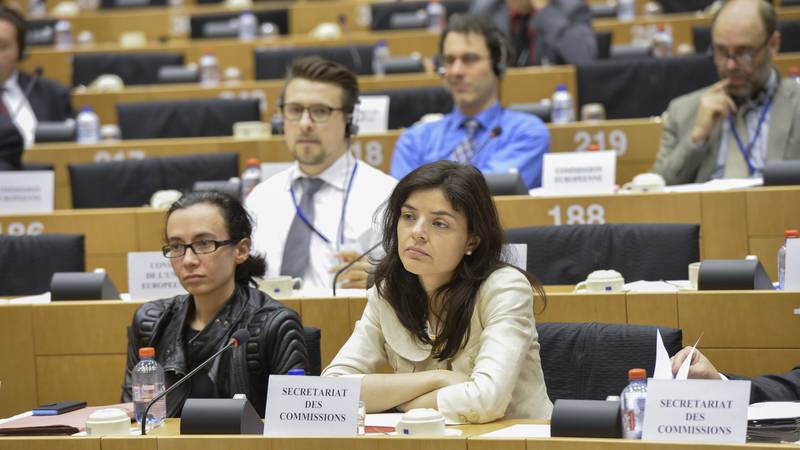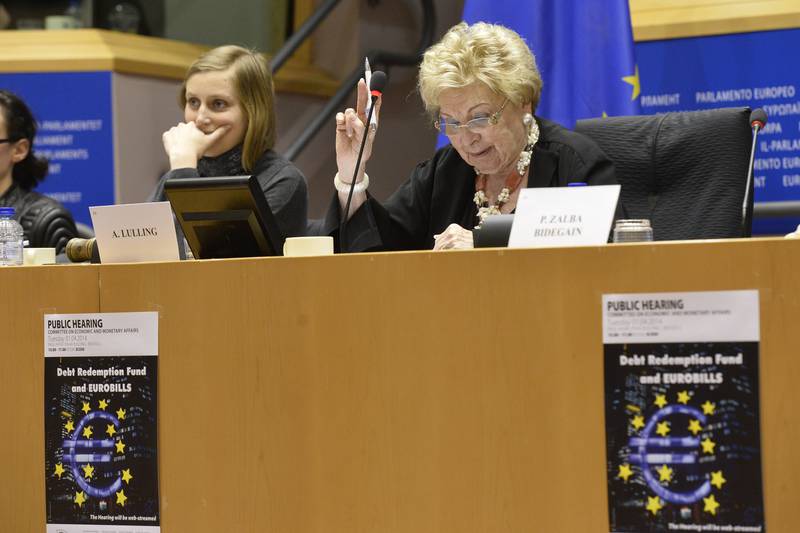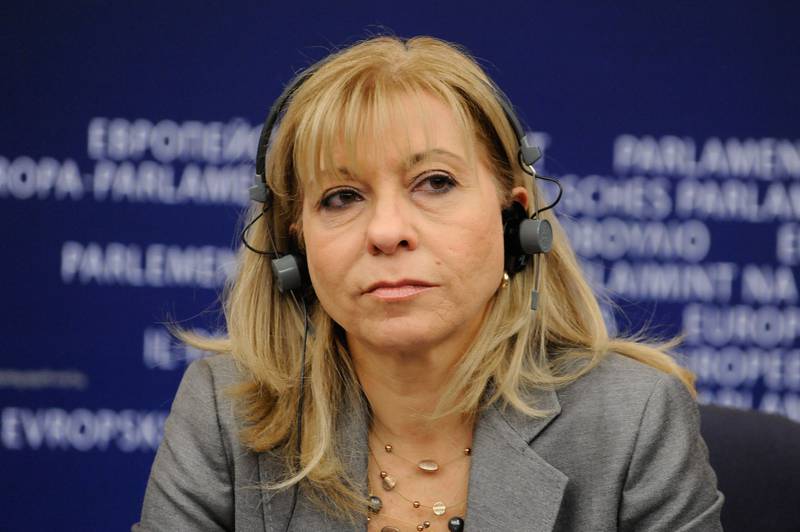Is There No Longer a Need of Eurobonds?
Adelina Marini, April 26, 2014
 Do you remember the hysteria of the financial markets in the beginning of the crisis when Greece defaulted and that unleashed a series of problems in the euro area with the semi-defaults of Ireland, Portugal, then the banking troubles of Spain. There were problems in Italy, too. Then, the financial markets dictated the agenda in the EU, the frequency of the summits, the solidity of the solutions. There was intense race between the opening of the markets and the agreeing of another bailout package, the purpose of which was to safeguard the euro area from a break-up due to excessive indebtedness and inability to protect itself from speculators. Credit ratings were falling one by one, the costs of new debt were rising rapidly, and the day in the EU appeared to be too short to find an exit from the crisis which became known as the euro area debt crisis.
Do you remember the hysteria of the financial markets in the beginning of the crisis when Greece defaulted and that unleashed a series of problems in the euro area with the semi-defaults of Ireland, Portugal, then the banking troubles of Spain. There were problems in Italy, too. Then, the financial markets dictated the agenda in the EU, the frequency of the summits, the solidity of the solutions. There was intense race between the opening of the markets and the agreeing of another bailout package, the purpose of which was to safeguard the euro area from a break-up due to excessive indebtedness and inability to protect itself from speculators. Credit ratings were falling one by one, the costs of new debt were rising rapidly, and the day in the EU appeared to be too short to find an exit from the crisis which became known as the euro area debt crisis.
Back then, one of the most discussed issues was the introduction of eurobonds as the most powerful weapon against the attacks of the financial markets. Or, at least, it was believed to be. The topic was on the agenda in 2010 when the then Prime Minister of Luxembourg and Eurogroup chief Jean-Claude Juncker (currently a candidate for the European Commission president's seat) and the then Italian Minister of Finance Giulio Tremonti came up with a joint idea to create a European debt agency that was supposed to issue eurobonds worth 40% of the EU gross domestic product. Their motives were that this would send a clear message to the financial markets about the "irreversibility of the euro". Mr Juncker and Mr Tremonti also believed that this would impose market discipline on the governments by in the same time safeguarding them from speculators' attacks. It is worth noting, that Jean-Claude Juncker has said in the beginning of his campaign that he is against eurobonds, obviously in an attempt to win the German conservatives on his side. "If I'm elected president of the European Commission, there will be no eurobonds because the conditions for sharing even partially of debt have not been fulfilled", he said in Berlin on April 5th.
In the end of 2011, the European Commission published a green paper for eurobonds in which it proposed three options for sharing of debt, risk and benefits. In fact, those are rather different stages than options. The first stage of debt sharing is the maximum one, which means a complete replacement of national debt issuance with "stability bonds" with solidarity guarantees. This option, however, requires treaty change. The second option is semi-bonds, called by the Commission a "blue-red approach", in which only part of national debt issuance is replaced by stability bonds with solidarity guarantees. And the third degree is partial replacement of national debt with common bonds with proportionate guarantees from the euro area member states.
The idea was not met with applause by the countries with excellent or next to excellent credit raring because to them this meant fiscal transfers to countries that do not deserve such solidarity because they are not ready to make sacrifices and tough reforms. Besides, there were justified fears that entering a new process of treaty changes would take too much time which the euro area at the time of systemic market pressure did not have. The idea was strongly supported by the Liberals in the European Parliament and especially by their leader Guy Verhofstadt, former prime minister of Belgium and currently an ALDE candidate for the European Commission president post.
Since then, a lot of time has passed and a lot of things have happened. The economic governance of the EU and the euro area in particular has been seriously reformed and enhanced by the six-pack of legislative proposals which introduced the European semester and enhanced economic coordination, the two-pack which increases control over the economic and fiscal policies of the countries that share the common European currency, the intergovernmental agreement for the fiscal pact, the banking union with its three main pillars - the supervisory mechanism, the banking resolution mechanism and the deposit guarantee scheme. A permanent bailout fund for the eurozone has also been created - the European Stability Mechanism (ESM) with minor changes to the Treaty. The market hysteria has abated, the euro area has been moving toward recovery, although slowly and reversibly and as if everything seems forgotten.
Do we still need eurobonds?
Almost a year ago, the European Commission has decided to, still, maintain the fire on the issue of eurobonds which was completely abandoned in the process of construction of the banking union launched in June 2012. The Commission created an expert group and tasked it to prepare an in-depth analysis of the possible benefits, requirements and hurdles before a partial debt sharing. The group presented [a record of the presentation in various languages] the final report from their work in the European Parliament's economic committee on April 1st. However, the haste to close this dossier before the end of the Parliament's term, and the Commission's for that matter, was obvious because the members of the committee were not acquainted before the hearing with the report and were reading the main conclusions during the hearing. The European Commission, too, had not presented its opinion on the report beyond the general statements of President Barroso who pointed out that the analysis showed the need of "deep political reflection and possible changes to the EU Treaty".
Whatever decisions are to be taken in the future, Mr Barroso added, before that there needs to be a democratic debate with the citizens, governments and the European Parliament. The European elections are a wonderful opportunity for such a debate, also said the former Portuguese prime minister. Olli Rehn, vice president of the Commission and EU commissioner for the euro area and the monetary affairs of the EU, was cautious in his assessment, but he said something that became obvious in the end of the parliamentary term - the treaties are exhausted for the completion of the euro area as a "genuine"  Economic and Monetary Union (EMU). According to him, the analysis of the expert group can be used mainly to "enrich" the debate about future institutional reforms.
Economic and Monetary Union (EMU). According to him, the analysis of the expert group can be used mainly to "enrich" the debate about future institutional reforms.
The moment has been especially appropriate for a discussion on the issue because the question no longer is should the treaties be opened to changes but when. In the road map for the deepening of the eurozone integration, which President Barroso presented upon his own initiative in the end of 2012, it is envisaged debt mutualisation to happen in the third phase which covers a period bigger than five years from then. That means, probably in the end of the term of the next Commission. In the document of the four presidents under the leadership of Herman Van Rompuy, however, eurobonds are not envisaged.
The expert group worked mainly in two directions in their analysis. The first is the establishment of a debt redemption fund after the idea of the German council of economic experts. This fund is to mutualise debt above the 60% of GDP ceiling in a combination of implementing a comprehensive set of rules and commitment by the participant states, the so called "conditionality". Commitments are applied even now as a pre-condition for bailouts from the European Stability Mechanism. The second direction is the establishment of short-term bonds, eurobills, with one or two years of maturity which are to be issued jointly by the euro area. The long-term bonds remain a national problem.
According to the chairwoman of the expert group Gertrude Tumpel-Gugerell, the establishment of the fund will mean transferring between 1.8 and 3.1 trillion euros of debt. The maximum size of the fund will be between 1.7 and 2.85 trillion euros with an expiration term of between 10 to 25 years. In order for the fund to be sustainable, however, it should be accompanied by very strict commitments by the participating countries because debt sharing is a huge long-term commitment. The need of treaty change for its establishment is the smallest of all problems, Ms Tumpel-Gugerell believes, because the risks the group sees are lack of flexibility, increase of interest rates for high credit quality countries and, most of all, because of the so called moral risk - the beneficiary countries not to stick to their commitments.
The size of the fund for the second option - the eurobills - will depend on the covered maturity. If it is for two years, then the expected size will be around 0.8 trillion euros which is based on the existing data for the short-term debt. The maximum size of the fund will be around 1.8 trillion euros if 30% mutualisation of government debt is agreed. If the maturity is only a year, the size of the fund will then be minimum around 0.5 trillion euros and maximum 0.9 trillion. This option also requires treaty changes. The experts, however, offer an option to make a hybrid of the kind that was invented for the banking resolution mechanism - a combination of European legislation and intergovernmental agreement if it is decided that the introduction of eurobonds is in some form urgent.
Is it urgent?
The experts were unanimous that no matter the already undertaken measures for stabilisation of the euro area the levels of government indebtedness continue to be excessive. Moreover, there is an increase in the past years. The Eurostat data from April 23rd for 2013 show that in the euro area the government debt to GDP ratio has increased from 90.7% in 2012 to 92.6% in the end of 2013. The countries with highest debt which actually represents a danger of a return of market hysteria, are Greece (174.1%), Italy (132.6%), Portugal (129.0%), Ireland (123.7%), Cyprus (111.7%) and Belgium (101.5%). Agnes Bénassy Quéré from the Paris School of Economics, a member of the expert group, believes that although a lot has been done to reduce the risk of a liquidity crisis, mainly thanks to the creation of the European Stability Mechanism and the ECB monetary operations (OMT), the high levels of indebtedness suggest that the entire system is very likely to remain risk prone with severe consequences, like, for instance, spillovers in other member states or, again, to resort to taxpayers saving banks.
This is a very serious warning given that the banking union was created precisely with the aim to break the so called "vicious circle" where taxpayers bailout the banks. Beatrice Weder di Mauro, another member of the expert group and professor of international macroeconomics in the University of Mainz, also believes that high indebtedness in many euro area countries is growing which endangers the growth perspectives and increases the number of lost decades. That is why, no matter how relevant it is to discuss debt sharing, this will not resolve the problem of debt. She told the MEPs that in the coming decades very seriously measures to reduce excessive debt should be considered.
Gertrude Tumpel-Gugerell pointed out, too, that debt sharing definitely will not be a replacement for necessary reforms. It could mitigate the pain but will not be a solution. Besides, the question what form of debt sharing will be selected is also very important. If the urgent option is perceived with the aim to avoid treaty change, the effect will be minimal which is why the experts declined to forecast how much will it cost. It is better to consider things in their depth during a process of treaty reforms, she recommended. Another thing the experts were unanimous about was that it should be awaited to see what impact will the reforms of economic governance have.
The European semester is only in its fourth year and the two-pack has been launched in the end of last year and it is still too early to tell if it works well. The biggest problem, however, remains the lack of confidence among the member states, often called a moral risk. That is why MEP Marianne Thyssen (EPP, Belgium) said that up to date the EU cannot afford any legal uncertainty. Such instruments like debt mutualisation should be established on the basis of full legal certainty. Beyond the purely technical  data about the benefits and minuses of eurobonds, the big problem are political consequences. Practically, there is no way to force member states to stick to their commitments.
data about the benefits and minuses of eurobonds, the big problem are political consequences. Practically, there is no way to force member states to stick to their commitments.
Moreover, there is a growing frustration on political and civil level from the high unemployment and the painful years of reforms in the crisis countries. Greek MEP Anni Podimata (Socialists and Democrats) asked whether the problem with debt unsustainability in the troubled countries could be resolved in the short or longer term so that they can successfully return to the market. She was outraged that, again, conditionality was mentioned and recalled that the sticks have become too many while there are no longer carrots. The question is very timely especially given that Ireland has returned on the financial markets, Greece, too, made a debut with a first issuance and Portugal has returned to the markets on April 23rd.
It is obvious that debt sharing, at least in the form the expert group considered, is not a panacea and can be adopted only as a complement to a much more comprehensive deepening of the euro area integration. Integration which will resolve the problem with moral risk, which is non-implementation of commitments or repeal of commitments when governments change. The discussion in the European Parliament's economic committee on April 1st did not shed too much light on whether there is a need of eurobonds or if they are urgent, but it showed very clearly that the euro area problems are far from gone and unless at least the recent efforts continue as a minimum and as a maximum they become more widespread and long-term, the crisis will return again with a terrible force. This time, though, it could have much more severe consequences against the backdrop of the huge unemployment, growing eurofugal forces and, generally, the complete loss of confidence in the European project. So, Barroso is right that now is the time to discuss the future.
 Klaus Regling | © Council of the EU
Klaus Regling | © Council of the EU Mario Centeno | © Council of the EU
Mario Centeno | © Council of the EU Mario Centeno | © Council of the EU
Mario Centeno | © Council of the EU